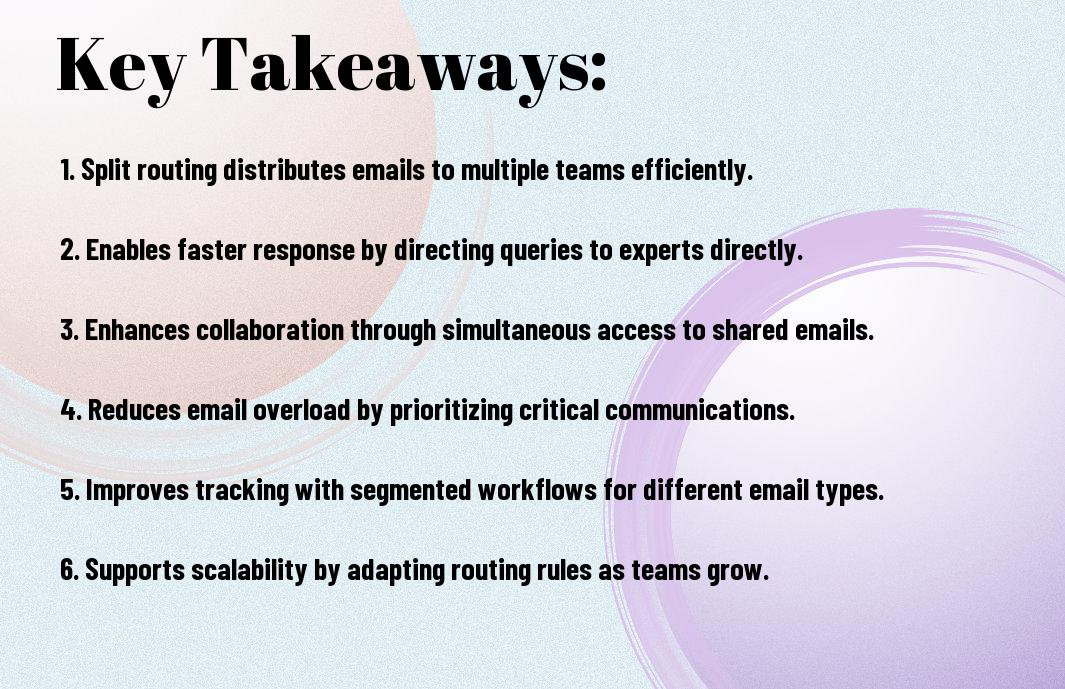Routing your emails efficiently can significantly enhance your workflow agility. By implementing split email routing, you can direct incoming messages to different teams or individuals based on specific criteria, allowing for quicker responses and better task management. This strategy not only streamlines your communication but also enhances collaboration within your organization. In this post, you will discover practical steps to leverage split email routing effectively, ensuring that your processes are more efficient and responsive to your business needs.
Key Takeaways:
- Implement split email routing to direct messages to specific teams or individuals based on predetermined criteria, enhancing responsiveness and accountability.
- Utilize automation tools to streamline the routing process, reducing manual labor and minimizing response times for incoming inquiries.
- Analyze the performance of the routing setup regularly to identify areas for improvement and adjust workflows as needed for optimal efficiency.
- Encourage collaboration among teams by ensuring that routed emails can still be accessed by relevant personnel, fostering a more holistic approach to customer service.
- Leverage metrics and reporting tools to evaluate the impact of split routing on overall workflow agility, allowing data-driven decisions for future optimizations.
Unpacking Split Email Routing: A Game Changer for Teams
Understanding split email routing unveils a new level of efficiency for teams. This method intelligently directs incoming emails to specialized groups based on predefined criteria, ensuring that every inquiry reaches the right hands without unnecessary delays. By facilitating targeted responses, split email routing enhances communication within teams and amplifies overall productivity.
The Mechanics of Split Email Routing
Split email routing operates through sophisticated algorithms that analyze incoming email attributes such as keywords, sender addresses, and subject lines. This process allows your email system to categorize messages automatically and route them to designated team members or departments. The setup is often customizable, allowing you to adjust parameters based on your unique needs and the dynamics of your team.
Key Benefits That Drive Efficiency
Implementing split email routing can lead to substantial efficiency gains. It minimizes response times and reduces the risk of emails slipping through the cracks. By ensuring the right team members handle specific queries, you empower your staff to utilize their expertise fully, which can lead to improved satisfaction for both clients and team members alike.
The time savings from reduced back-and-forth communication are significant, as teams can quickly address the concerns of clients or colleagues. For instance, companies that have adopted split email routing report up to a 30% increase in their response rate. You can also improve accountability, as team members will know that they are directly responsible for specific email types, leading to a shared sense of ownership and commitment to quality service. With streamlined communication channels, your team is better positioned to focus on core tasks, ultimately driving better outcomes for projects and client relationships.


Crafting a Strategy for Implementation
Effective implementation of split email routing requires a well-defined strategy that aligns with your organizational goals. Begin with a thorough understanding of how email routing can support your specific business needs, ensuring that both efficiency and team collaboration are prioritized. A successful approach typically includes assessing current workflows and establishing the necessary infrastructure for smooth operation.
Assessing Current Email Workflows
Start by mapping out your existing email workflows to pinpoint areas for improvement. Identify bottlenecks and inefficiencies that may compromise productivity. Examine how emails are currently processed, who handles them, and what tools are utilized in the process. Gathering input from your team will also provide valuable insights into where forces can be aligned to enhance responsiveness.
Setting Up the Right Infrastructure
Establishing the right infrastructure for split email routing is vital for seamless integration. Ensure your email platform supports advanced routing rules and segmentation capabilities, enabling you to direct emails based on specific criteria. Consider including CRM systems or help desk platforms that work in tandem with your email system to provide additional context for better decision-making.
To create a solid foundation for split email routing, invest in tools that facilitate automation and integration. For instance, integrating platforms like Zapier or leveraging built-in features of your email client can help streamline processes. Additionally, workforce training on these tools can unlock their full potential, with employees equipped to handle segmented emails intuitively. Having robust reporting mechanisms in place will further allow you to analyze the performance and constantly refine your workflow strategy over time.
Maximizing Collaborative Potential Through Split Routing
Utilizing split routing effectively amplifies team collaboration by assigning emails based on specific roles, ensuring that expertise is leveraged for optimal productivity. This approach not only streamlines responses but also cultivates a focused environment where each member can contribute according to their strengths. It fosters a culture of shared responsibility while reducing the overload common in traditional email management.
Role-Based Email Distribution
By implementing role-based email distribution, you enhance the speed and efficiency of your team’s operations. This system categorizes emails based on the function or expertise needed, directing inquiries and tasks to the appropriate team members. For instance, sales queries might go directly to the sales department, while technical issues are routed to IT. This targeted approach minimizes response time and elevates the quality of customer interactions.
Enhancing Communication Among Teams
Clear communication becomes seamless with split email routing as it promotes direct access to relevant team members. By ensuring that individuals receive only the emails pertinent to their work, interruptions are minimized, allowing them to focus better on their responsibilities. Enhanced communication not only shortens the feedback loop but also fosters a collaborative spirit as team members can coordinate more effectively when discussions are relevant to their specific roles. This results in healthier dialogues and more fruitful collaborations across departments, ultimately driving your organization’s success.

Performance Metrics: Measuring Success of Split Email Routing
Analyzing performance metrics is necessary for understanding the effectiveness of your split email routing strategy. Metrics such as response time, email resolution rates, and overall team productivity can provide insights into how well your split routing enhances workflow agility. You can determine if the structure of routing aligns with key performance indicators (KPIs) that reflect your team’s operational goals, allowing for adjustments and continuous improvement over time.
Key Indicators of Workflow Agility
Key performance indicators should focus on measuring speed and efficiency. These can include average response time to emails, the rate of issues resolved within a defined timeframe, and the satisfaction level of internal teams. Monitoring these aspects creates a clearer picture of workflow agility and shows how effectively resources are utilized in response to incoming communications.
Tools for Monitoring and Analysis
Utilizing advanced tools for tracking email performance enhances your insight into the split routing process. You can employ CRM systems, email analytics platforms, and even custom dashboards that aggregate data from various sources. These tools help you visualize trends, identify bottlenecks, and assess performance against established metrics.
For instance, tools like HubSpot or Salesforce offer built-in analytics that allow you to monitor response times and team workloads effortlessly. You can set benchmarks for performance and use real-time dashboards to adjust routing strategies based on live data. Integrating services like Google Data Studio accumulates information from multiple metrics, giving you a comprehensive overview that supports data-driven decision-making. Access to these analytics fosters a responsive environment, enabling you to pivot swiftly as email interactions evolve and requirements change.
Future-Proofing Your Email Strategy
Embracing a future-ready email strategy involves continually assessing your workflows to ensure adaptability. As customer expectations and team dynamics evolve, revisiting your email routing tactics will keep you ahead of the game, enabling your organization to respond quickly to changing environments and maintain high productivity levels.
Adapting to Emerging Communication Trends
Staying relevant in the face of emerging communication trends ensures your email strategy remains effective. By analyzing industry shifts, such as the increasing preference for instant messaging or video conferencing, you can integrate these tools into your email workflow, thereby improving team collaboration and enhancing customer engagement.
Preparing for Shifts in Technology
Modern technology continuously reshapes how teams and clients communicate. Adapting split email routing means you’ll need to stay informed about advancements in email platforms, AI tools, and automation software that can streamline your processes even further.
For instance, the rise of AI-powered chatbots can complement your email routing by addressing routine inquiries before they hit your inbox. Incorporating tools like machine learning or predictive analytics further refines how you manage communication, making your workflows more flexible and responsive to shifts in both technology and customer preferences. As the email landscape unfolds, integrating these innovations will safeguard your strategy against obsolescence and improve overall operational efficiency.
To wrap up
Conclusively, leveraging split email routing can significantly enhance your workflow agility by ensuring that the right information reaches the right team members efficiently. By strategically directing emails based on predefined rules, you can minimize response times and streamline processes. This approach not only improves collaboration but also allows you to focus on critical tasks. For more insights into optimizing your workflow, consider exploring Workflow Management: Strategies & Best Practices.
FAQ
Q: What is split email routing?
A: Split email routing is a technique that distributes incoming emails across multiple teams or systems based on predefined rules or criteria. This approach ensures that emails are directed to the most appropriate handlers, enhancing response times and improving overall workflow efficiency.
Q: How can split email routing improve workflow agility?
A: By directing emails to the right teams or individuals based on their expertise or operational focus, split email routing minimizes delays in response and processing times. This can lead to quicker resolutions and allows teams to operate more flexibly, adapting to workload changes without the bottlenecks that can occur with traditional email handling methods.
Q: What are the key components to set up effective split email routing?
A: To implement effective split email routing, organizations should define clear routing rules based on factors such as email content, urgency, and sender information. Additionally, utilizing automation tools and email management software can streamline the routing process and ensure that emails are handled with minimal manual intervention.
Q: Can split email routing integrate with existing email systems?
A: Yes, most modern email systems support integration with various automation and routing tools. Implementing split email routing does not usually require a complete overhaul of existing systems, but rather a configuration of the current email platform to include the necessary rules and processes that enable this routing approach.
Q: What challenges might organizations face when implementing split email routing?
A: Organizations may encounter challenges such as the need for staff training, potential initial resistance to new processes, and the requirement for ongoing maintenance of routing rules to ensure they remain effective. Regular evaluations and adjustments will be necessary to refine the system and address any emerging issues that impact workflow efficiency.

